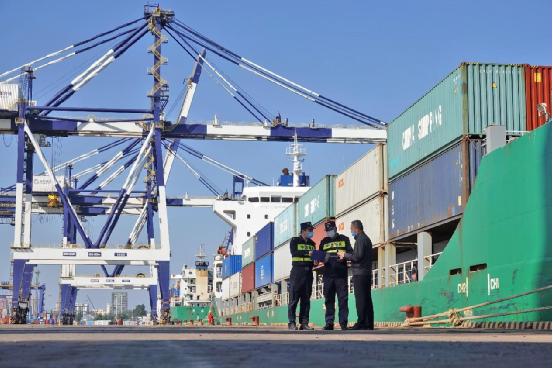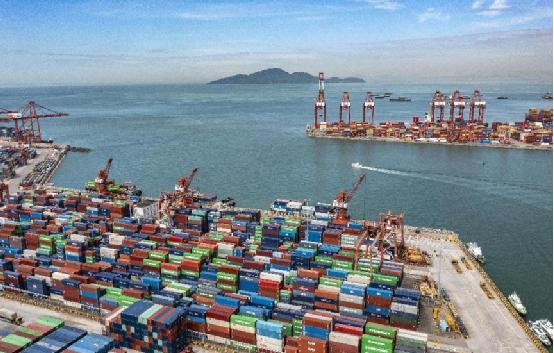China continues advancing high-level opening-up
Since a protocol on upgrading the free trade agreement (FTA) between China and New Zealand officially took effect on April 7, companies have enthusiastically followed relevant procedures to enjoy the benefits brought about by it.

Customs officers inspect foreign trade containers at an international container terminal of Yantai Port, east China’s Shandong province, Oct. 12, 2021. (People’s Daily Online/Tang Ke)
The protocol, which was signed by the two sides in January 2021, is based on their FTA signed in 2008, the first of its kind between China and a developed country. The upgrading of the FTA reflects how China continuously promotes high-level opening-up.
“In the past, we can only apply for certificate of origin before shipment or on the day of shipment. Sometimes when the shipping information wasn’t available in time, we couldn’t handle it. Since the FTA has been upgraded, we are able to go through the procedure after shipment, which is much more convenient,” said an executive with a trade company based in Shenzhen, south China’s Guangdong province.
Since the beginning of this year, the company has applied for and successfully got eight certificates of origin under the China-New Zealand FTA at a division of Shenzhen Customs District, which helped it enjoy import tariff reductions and exemptions worth about 1.7 million yuan ($253,875) in New Zealand.
According to Wang Shouwen, Chinese Vice Minister of Commerce, China has so far sealed 19 FTAs with 26 countries and regions in Asia, Oceania, Latin America, Europe and Africa, almost doubling the figure ten years ago, and its trade with them accounted for about 35 percent of China’s total foreign trade.
While increasing the number of its FTAs, China has also constantly improved their quality.
China sees lower tariff level and higher customs clearance efficiency in trade in goods. “Since 2012, China has signed nine new FTAs with foreign countries. In most of the agreements, more than 90 percent of the goods enjoy zero tariffs; and in some, the proportion reaches as high as 97 percent,” Wang pointed out.

Photo taken on May 19, 2022 shows the busy and orderly Shekou Container Terminal in Shenzhen, south China’s Guangdong province. (People’s Daily Online/Wang Meiyan)
Speaking of customs clearance efficiency, Wang noted that it only takes less than one and a half days for imports to complete customs clearance in China, compared with about four days in 2017. And goods exported from China only need about 1.2 hours for customs clearance, one-tenth of the time needed in 2017, he added.
China has lowered the market threshold and further expanded opening-up in trade in services and investment. “In trade in services, China pledged to open the market for 100 subsectors when we joined the World Trade Organization (WTO). And in the recent Regional Comprehensive Economic Partnership (RCEP) agreement, we added 22 more service sectors,” Wang said.
Besides, the country has adopted negative lists for foreign investment, committing higher-level opening-up in manufacturing, agriculture, mining and other fields, he added.
As China opens its door wider, its number of free trade partners is also growing.
The RCEP’s entry into force at the beginning of 2022 marked the formation of a free trade zone involving the largest population and largest trade scale in the world, Wang pointed out.
Since it took effect, the RCEP has constantly unleashed trade dividends and injected new impetus into regional economic development. Data showed that China’s imports and exports with the other 14 RCEP members totaled 2.86 trillion yuan (about $428 billion) in the first quarter of this year, which represented a year-on-year increase of 6.9 percent and accounted for 30.4 percent of the country’s total trade.

A staff member with the trade promotion council of Qinhuangdao, north China’s Hebei province, shows the first certificate of origin under the Regional Comprehensive Economic Partnership (RCEP) issued by the council, Jan. 28, 2022. (People’s Daily Online/Cao Jianxiong)
According to Wang, China’s Ministry of Commerce (MOFCOM) is speeding up multiple FTA negotiations. The country will make active efforts to advance its accession into the Comprehensive and Progressive Agreement for Trans-Pacific Partnership (CPTPP) and the Digital Economy Partnership Agreement (DEPA), and facilitate negotiations on a China-Japan-South Korea FTA as well as its FTA negotiations with the Gulf Cooperation Council (GCC), Israel and Ecuador.
China will promote the expansion and improve the quality and efficiency of its free trade zone (FTZ) network, and further elevate the level of its FTAs; it will implement zero tariffs on a larger proportion of goods, ease market access for trade in services and investment, and actively participate in negotiations on new topics such as digital economy and environmental protection; the country will also make efforts to improve the comprehensive utilization rate of FTAs and enhance their effectiveness so as to make them better benefit enterprises and people in relevant countries at a faster pace.

Tourists purchase commodities introduced into China through the China International Import Expo (CIIE) at a “CIIE bazaar” on Nanjing Road Pedestrian Walkway, east China’s Shanghai municipality, Nov. 8, 2021. (People’s Daily Online/Li Lizhen)
As the number of China’s free trade partners continuously expands, more and more Chinese and foreign companies will enjoy the benefits of the country’s higher-level opening-up, Wang noted.
Photos
Related Stories
- Xi's Economic Agenda: Firmly pushing opening-up in unstable, uncertain world
- China's high-level opening-up delivers win-win outcomes to world
- China to pursue higher-standard opening up
- China to continue to expand high-level opening up: spokesperson
- China to deepen reform, opening-up to contribute to global economic recovery: FM spokesperson
- China to promote capital market opening-up in 2022: regulator
- China secures extraordinary achievements in expanding high-level opening up in 2021
- China steps up efforts to accelerate reform, opening-up
- Chinese premier stresses effective macro policies, further opening-up
- Experts speak highly of China's opening up wider to world
Copyright © 2022 People's Daily Online. All Rights Reserved.









